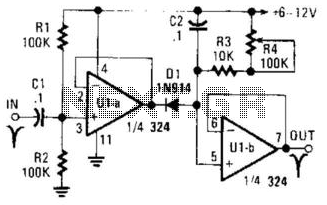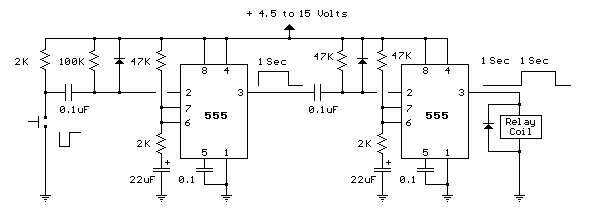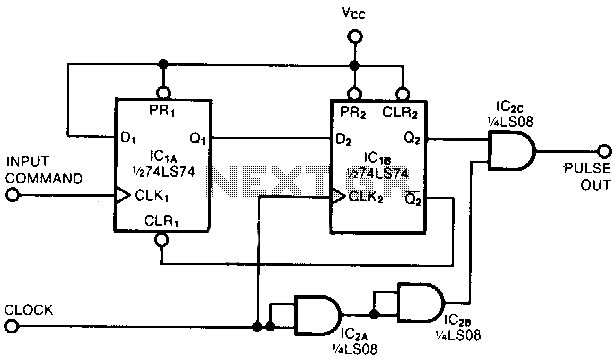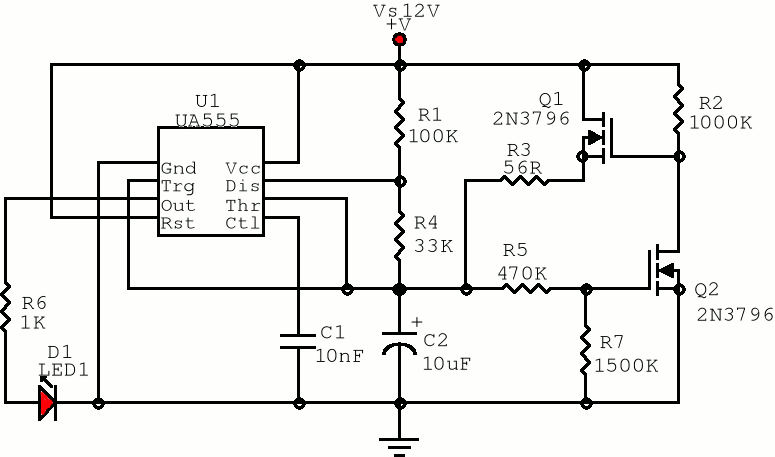
Negative Pulse Stretcher

U1A functions as an amplifier that drives D2 and charges C2. U1B operates as a voltage follower. R3 and R4 set the amount of stretch applied to the input pulse. C2 is capable of being charged to handle varying pulse rates.
In this circuit, U1A serves as a critical amplification stage, enhancing the signal strength from the input source before it reaches the diode D2 and capacitor C2. The role of D2 is to allow current to flow in one direction, effectively protecting the circuit from reverse polarity and ensuring that C2 is charged appropriately. The capacitor C2 plays a pivotal role in the circuit, storing energy and smoothing out the voltage levels to accommodate different pulse rates.
U1B, designated as a voltage follower, provides high input impedance and low output impedance. This configuration ensures that the voltage at the output follows the voltage at the input without loading the previous stage, making it ideal for buffering signals.
Resistors R3 and R4 are integral to controlling the pulse stretching mechanism. By adjusting their values, the timing characteristics of the circuit can be altered, allowing for fine-tuning of the input pulse's duration before it is processed by the subsequent stages. This flexibility is essential for applications requiring precise timing and pulse width modulation.
Overall, the circuit demonstrates a well-coordinated interaction between amplification, voltage following, and timing control, making it suitable for various electronic applications where pulse shaping and signal integrity are paramount. U1A acts as an amplifier, which drives D2 and charges C2. U1B acts as a voltage follower. R3 and R4 determine the amount of stretch that the input pulse receives. C2 can be charged to accommodate different pulse rates.
In this circuit, U1A serves as a critical amplification stage, enhancing the signal strength from the input source before it reaches the diode D2 and capacitor C2. The role of D2 is to allow current to flow in one direction, effectively protecting the circuit from reverse polarity and ensuring that C2 is charged appropriately. The capacitor C2 plays a pivotal role in the circuit, storing energy and smoothing out the voltage levels to accommodate different pulse rates.
U1B, designated as a voltage follower, provides high input impedance and low output impedance. This configuration ensures that the voltage at the output follows the voltage at the input without loading the previous stage, making it ideal for buffering signals.
Resistors R3 and R4 are integral to controlling the pulse stretching mechanism. By adjusting their values, the timing characteristics of the circuit can be altered, allowing for fine-tuning of the input pulse's duration before it is processed by the subsequent stages. This flexibility is essential for applications requiring precise timing and pulse width modulation.
Overall, the circuit demonstrates a well-coordinated interaction between amplification, voltage following, and timing control, making it suitable for various electronic applications where pulse shaping and signal integrity are paramount. U1A acts as an amplifier, which drives D2 and charges C2. U1B acts as a voltage follower. R3 and R4 determine the amount of stretch that the input pulse receives. C2 can be charged to accommodate different pulse rates.





